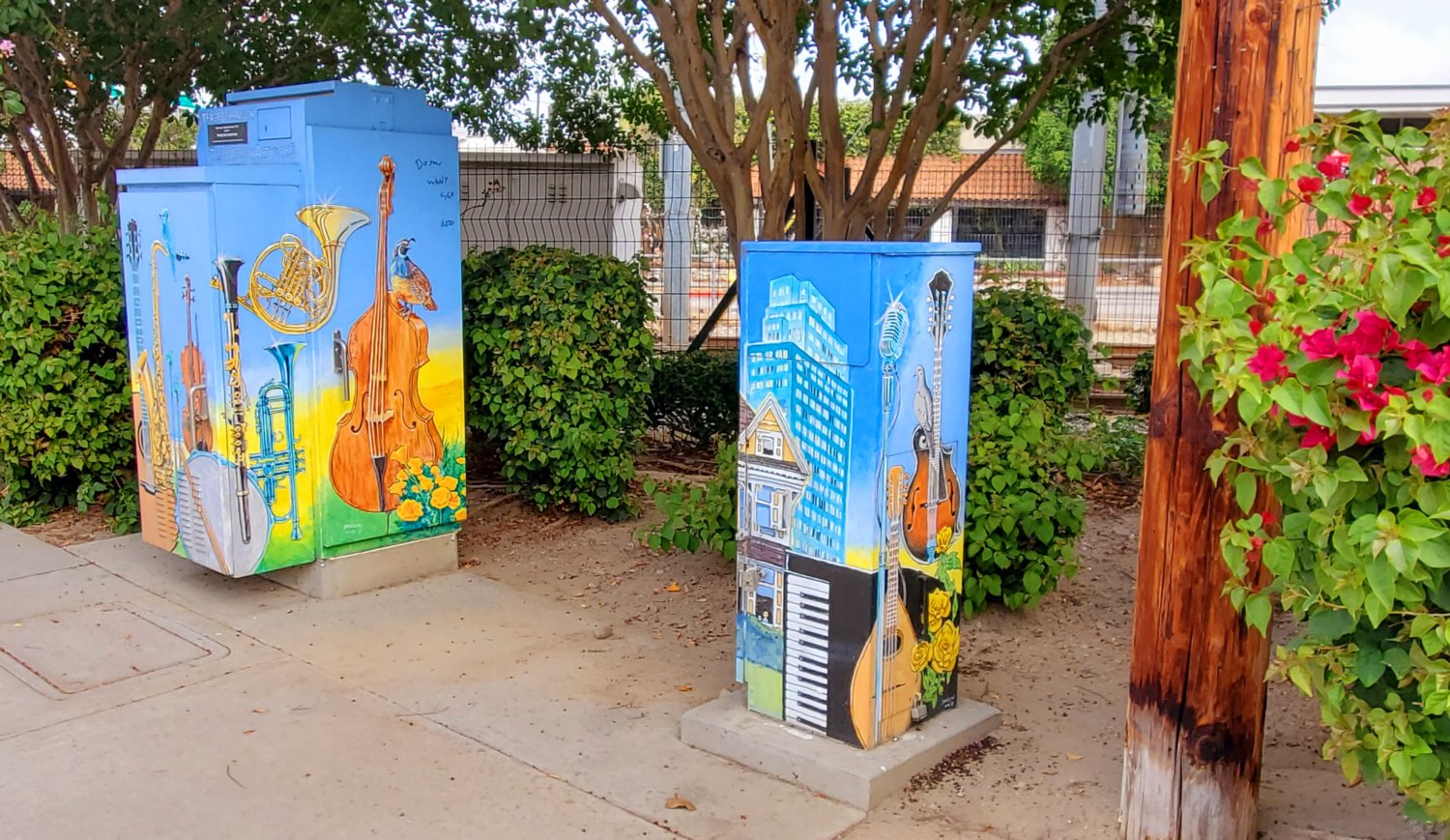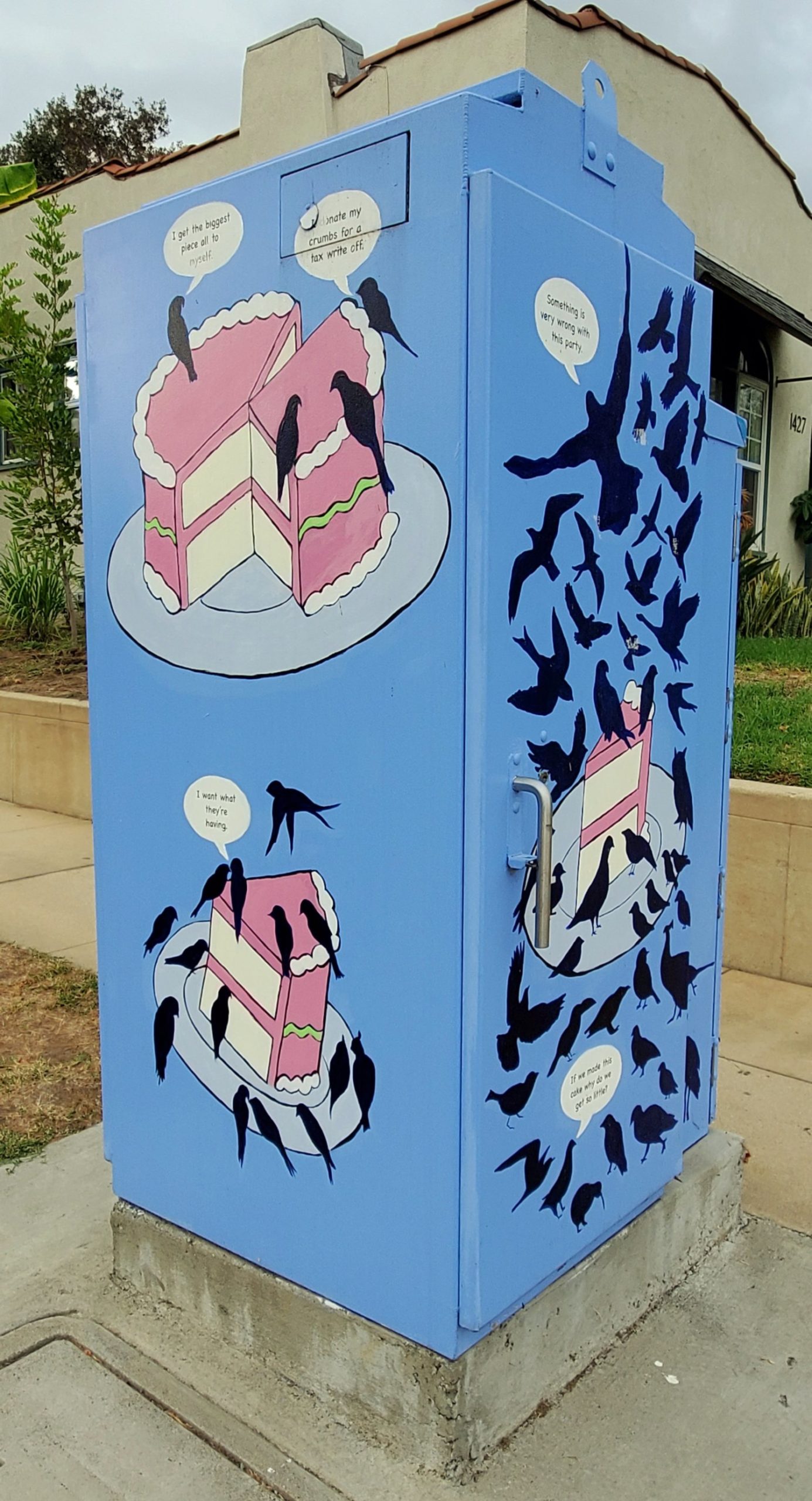
Colorfully painted utility boxes can be found all over town. The result of a successful public art project that spanned three years and co-sponsored by SPARC and the City of South Pasadena.
Rick Leddy, a South Pasadena resident, was inspired to write a poem for each utility box – thirty in all. Those poems were compiled into The Art Box Poems. We chatted with Rick about his writing process and of course, poetry.
What sparked you to write a poem for each utility box?
I am a huge fan of street art, whether it be sanctioned murals on buildings or the not-necessarily sanctioned subversive, sublime and humorous musings of the numerous street artists throughout Los Angeles. I’ve always loved the idea of the South Pasadena art utility boxes, because there is this thrill of discovering something beautiful on the street that you just weren’t expecting.
“The Art Box Poems” project started in 2018 when I walked past one of the art boxes and words just started flowing into my head about the imagery I saw. That was interesting and unexpected. Then I thought, maybe it would be cool to write poems about ALL of the art boxes. I actually didn’t know there were thirty of them, or I might have changed my mind.
I thought it was important that I find each box on foot. So, I mapped out a course to walk, not drive, around the city to find each and every utility box. South Pasadena is actually a small city. The South Pas government website describes it as a “mere” 3.44 square miles. Somehow, it magically expands into a major metropolis as you embark on a journey to find thirty art boxes on foot. But once I found an art box, besides wheezing and rubbing my shins, I would study it, take pictures, then move on to the next one.
The idea behind the poems was that they were going to be my interpretations of the works, and not attempts to mimic what the artists’ inspirations were when they painted them. I liken it to walking around an art museum and not reading the ubiquitous little cards beside the art works that explains them (I mean, who has time for that?).
I knew I ran the risk that some of the artists might be confounded or maybe even a tad miffed by my interpretations of their works. But, I thought, most of them don’t know where I live, so… (Actually, one of the artists recently approached me and said my interpretation was “interesting” and basically it wasn’t at all what she was thinking when she conceived of and painted the box. Thankfully, she really liked the poem, because she does know where I live.)

What is your favorite art style? What is your least favorite?
The art boxes, to me, are like your children. You love them all, but maybe you love them for different reasons. The same can be said for the poetry I wrote about the boxes. Art is entirely subjective. So, the art boxes you really love may not be the same ones I really love, as the poems that might really resonate with you, may not resonate with somebody else.
As I wrote this book, I determined that the poems would not all be in the same style and let the box itself determine what that shape that poem would take. So, there is haiku, a bit of rhyme, freestyle, and even a fairly long narrative poem that takes on an Aesop’s fable vibe.
The poems themselves are heartbreaking and funny. They deal with mental illness, aging, loss, joy, death, love, immigration, children, social media, alienation, religion, politics and race.
How important is the accessibility of meaning? Should one have to work hard to “solve” the poem?
I like to keep my poems accessible. And I have done that with varying degrees of success.
An example: I posted a poem to a South Pasadena Facebook group last year about the white peacock that seemed to be everywhere in South Pasadena during the pandemic. The white peacock reminded me of the mythic White Buffalo worshipped by the Lakota people. Each sighting seemed like it filled some spiritual need during a time that felt apocalyptic. There was a feel of the sacred about it all.
After I posted it, one of the readers wrote a comment stating that she was going to make sure her children, who were both in high school, read it. She stated that they both kind of hated studying poetry in school, so she wanted to show them that there was poetry that could be enjoyable to read.
I appreciated the compliment, but it also made me a bit sad, because I’ve listened to and read so many poems that are both beautiful and accessible.
The fact that you asked this question reveals the problem inherent with many people’s perception of poetry: that it is obscure, high-minded, difficult to understand and that it is something only a beret-wearing academic with an MFA in Literature can appreciate. It’s really not meant for the rest of us.
But, you have to remember that some of our most truly epic stories came down to us in poetic form: the Iliad and the Odyssey, Beowulf, Gilgamesh. Oral stories, memorized, then passed down from generation to generation were often expressed through poetry. The cadence and the beat of poetry was meant to be a form of communication that could be shared with others around a campfire beneath the expanding crystalline night.
The aim of my poetry, especially in “The Art Box Poems,” is not to baffle with hazy allusions and obscure literary references in some quest to prove to the reader how clever I am. If you don’t understand my poems, then I have been a bit lazy with the writing and in some sense have failed both myself and the reader. Yes, I always strive for my writing to be interesting, weaving phrases and words into interesting and unique patterns, but if you don’t understand what I’m trying to convey, if I’m not connecting with you, then what exactly is the point of it all?

Did you discover any common themes in the utility box art?
There are several boxes that involve parrots; at least four with parrots in them as main characters or background actors, I believe. The parrots are such a part of the South Pasadena experience, that I sometimes forget how woven into the fabric of the city they are. It’s only when visitors from outside the area stare upward and point in awe as a flock of parrots comes flying over like an awkward, garrulous, fingernails on chalkboard B-52 squadron, that I realize how used to them I’ve gotten.
There are a couple of boxes with ostriches, which makes sense too, given the history of the iconic Cawston Ostrich Farm, which initially put South Pasadena on the map.
Besides that, the themes are pretty diverse.
What is your writing process like?
With “The Art Box Poems,” my writing process varied, depending on how the boxes spoke to me. Some of the poems came fast and furious. Others were like pulling an impacted molar from a hippo.
Some of the art box poems came from personal stories and experiences. For instance, the poem, “Between Heaven and Earth,” was based on a true-life story told to me by a co-worker. The poem “Ducks,” was based on the seemingly simple experience of our children feeding ducks that became a rumination of the day when they would grow up and leave us.
Several of the poems, like “Tower of Babel” and “The Gold Rose,” are flights of fancy or fictionalized events. I like to think they all contain grains of truth and insights we can all relate to.

One of my personal favorite poems in the book, “Let Them Eat…” came out of left field. There is a box with cake painted on it that inspired me to write a poem about Marie Antoinette. I had it mostly written, but there was this little voice in the back of my head that said, “This is okay, but it doesn’t feel quite right.” Suddenly, I had this flash: “What if Twitter had been around when Marie Antoinette allegedly uttered the phrase, ‘Let them eat cake?’” The poem just took off from there as a Twitter feed, with Marie and King Louis and the cake-lovin’ peasants all chiming in, hashtags and all.
Sometimes, I am genuinely surprised at the direction a poem takes, and when that happens, it’s like discovering a beautiful piece of art on the street that you hadn’t expected. It just makes the journey all worthwhile
—
After many starts and stops over a three year period, The Art Box Poems is available for purchase with all proceeds going towards raising funds for SPARC. Many thanks to Rick for adding another dimension to the colorful utility boxes that dot the city.
Rick Leddy has written six books. His three poetry collections include, “Metro Mona Lisa: Poems of Travel and Travail in Los Angeles,” “365+1: A Year of Beauty and Madness,” and “The Art Box Poems.” He has lived in South Pasadena for over twenty years, and gets perturbed when people mistakenly call it Pasadena. That’s how you know he is a true South Pasadenan.















.png)






